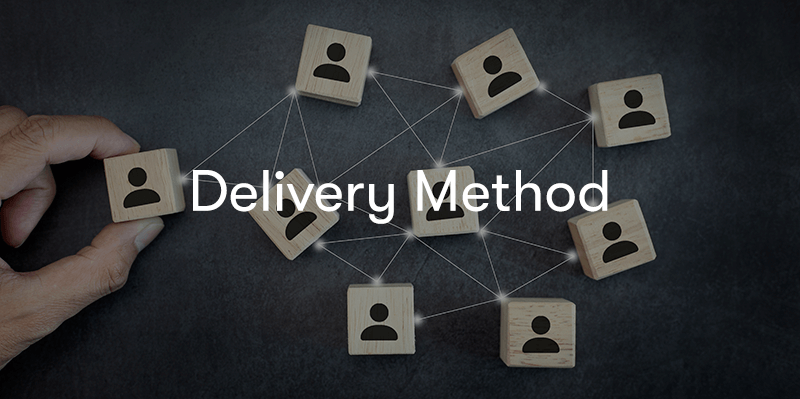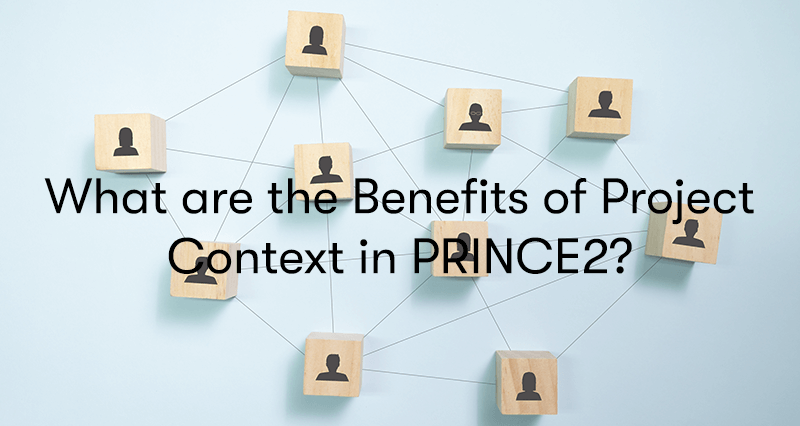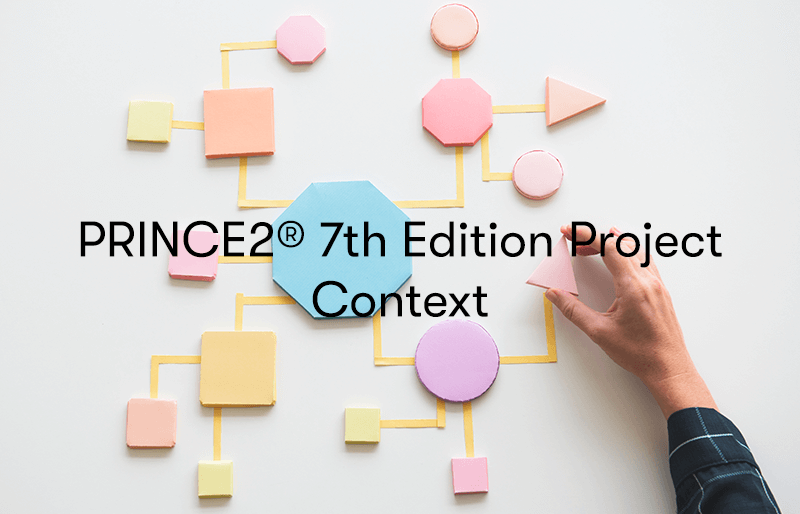PRINCE2® 7th Edition Project Context
What is PRINCE2 7th Edition Project Context?
PRINCE2 can work with any project no matter its:
- Organisation
- Commercial
- Delivery method
- Sustainability requirements
- Scale
- Size
PRINCE2 can be tailored to suit your project’s needs. If you would like to learn more about PRINCE2 7th Edition, please check out our PRINCE2 7th Edition Foundation course.
Organisational Context

The PRINCE2 approach operates without assuming a predetermined organisational context. Within this framework, there can exist individuals who define desired outcomes, suppliers responsible for furnishing resources and expertise to achieve these products, and business decision-makers tasked with justifying and sustaining project investments throughout its lifecycle.
The PRINCE2 methodology does not necessitate specific predefined relationships among users, suppliers, and business decision-makers. These roles can be held by entities within the same organisation or distributed across multiple different organisations with established commercial agreements.
In the PRINCE2 methodology, business decision-makers emerge from the organisation that initiates the project. Their decisions are influenced by the overarching business strategy, objectives, and organisational policies.
Commercial Context
The business might have engaged in a commercial partnership with a supplier to deliver products that fulfil the user-defined requirements as outlined in the project's business case. The entity responsible for executing the project will carry out this task to meet a specific need identified by the business.
The business could divide the project's tasks into one or more components, with some components requiring the involvement of external suppliers for delivery. Other components could be handled internally by the business itself, potentially by a department like IT or facilities. For a supplier, the tasks to be fulfilled might be covered by a legally binding contract, resulting from the procurement process. In order to execute these tasks, the supplier might engage subcontractors, further breaking down the work into additional elements.
Within a commercial setting, hierarchical structures of commercial relationships among suppliers may exist. Instead of a straightforward customer-supplier dynamic involving just two organisations, projects might entail multiple organisations governed by numerous contracts. A scenario could involve a single customer with a primary contractor, or it could encompass multiple customers and multiple supplier organisations, each with their own motivations for embarking on the project.
The agreement binding the involved parties outlines the collaborative approach between customers and suppliers to realise the project's objectives. The responsibilities and obligations detailed in the agreement should be mirrored in the project's management approach.
Delivery Method

The delivery method refers to the manner in which the project's tasks are executed. The project might utilise one or multiple delivery methods to generate the necessary products. Common delivery methods include:
Sequential-linear Approach (waterfall Approach)
This method involves executing the steps to create products in a sequential order, with the product becoming accessible during the project or by its conclusion.
Iterative-incremental Approach (Agile Approach)
Frequently employed, though not exclusively, in product development, this approach entails iteratively performing tasks like requirements gathering, design, development/coding, and testing throughout the project's lifecycle.
Hybrid Approach
This approach combines elements of both the sequential-linear and iterative-incremental methods. Certain project components follow a sequential-linear path, while others adopt an iterative-incremental approach. For example, a sequential-linear method could be utilised for constructing service infrastructure, followed by an iterative-incremental approach for developing a customer service portal.
PRINCE2 furnishes a structured environment for specialised delivery methods. It does not assume or mandate any specific delivery method. Any methodology can be applied by separating project management from specialised tasks involved in producing project products.
Sustainability Context
The business is prone to possess sustainability goals and obligations that the project must either adhere to or contribute towards. These factors will shape the project's objectives and its establishment and management approach. PRINCE2 incorporates sustainability requirements by integrating sustainability as one of the seven performance benchmarks utilised to oversee the project. Sustainability is also woven into the methodology through roles, documentation, practices, and processes.
Sustainability is frequently used interchangeably with environmental concerns. However, its interpretation can vary across different organisations. To some, it might pertain to the environmental ramifications of project endeavours, while to others, it could encompass the overall lifespan expenses of the products delivered by the project and their resilience during operational phases.
Scale
The PRINCE2 methodology possesses inherent flexibility, allowing for simplification in the context of smaller or uncomplicated projects or expansion for larger or intricate projects to ensure comprehensiveness.
The perceived magnitude of a project remains relative to the specific organisation. What might qualify as a small project within a vast multinational corporation could surpass what constitutes a large project within a smaller entity. It proves more beneficial to classify projects in terms of simplicity as opposed to size, and complexity instead of magnitude. The determination typically hinges on how the business gauges the risk and significance of the project in relation to its routine operations.
PRINCE2 can be adapted to the project's scope through:
- Adjusting governance arrangements spanning the business layer, project board, project manager, and teams.
- Selecting appropriate project roles from user, business, and supplier organisations.
- Tailoring the formality and level of detail present in project.
- Modulating the formality of project controls.
- Choosing and integrating management approaches, such as commercial management or change management.
- Determining the number of project stages and work packages into which the project is divided.
- Defining project performance targets and their allowable variances.
What are the Benefits of Project Context in PRINCE2?

The benefits of project context in PIRNCE2 include:
Flexibility for Project Scale
PRINCE2's adaptability allows for tailoring the approach based on the scale and complexity of the project. It can be streamlined for smaller or simpler projects or expanded for larger and more intricate endeavours, ensuring suitability and thoroughness.
Relative Perception of Project Size
Recognising that project size is relative to the organisation's scale, PRINCE2 advises thinking in terms of simplicity and complexity rather than using fixed size classifications. This approach acknowledges that the same project might be considered small in a large organisation but large in a smaller one, enabling more accurate project evaluation.
Risk and Importance Alignment
The project's perceived risk and significance relative to regular business operations guide project classification. By gauging these factors, businesses can better determine the appropriate level of effort, resources, and controls to allocate to the project.
Tailoring Governance and Roles
The PRINCE2 method supports adjusting governance arrangements and project roles to fit the project's specific context. This involves determining the composition of the project board, roles within user, business, and supplier organisations, and the level of role division or consolidation based on project complexity.
Customised Documentation and Controls
The project context drives the extent of formality and detail in project documentation, known as management products in PRINCE2. Similarly, the formality of project controls, including reporting frequency and review processes, can be tailored to suit the project's unique requirements.
Integration of Management Approaches
Depending on the context, PRINCE2 allows for the incorporation of various management approaches, such as commercial management or change management. This ensures that the chosen approach aligns with the project's specific needs and objectives.
Structured Project Divisions
The project's context determines factors like the number of stages and work packages into which the project is divided. This tailored structuring facilitates efficient management, monitoring, and control throughout the project lifecycle.
Targeted Performance Management
PRINCE2 enables setting project performance targets and their acceptable variances based on the project context. This approach ensures that performance management aligns with the unique goals and constraints of the project.
In essence, recognising and adapting to the project's context within the PRINCE2 framework allows organisations to optimise project management practices, allocate resources effectively, and achieve successful outcomes by tailoring their approach to suit the project's scale, complexity, and specific requirements.
Final Notes on PRINCE2 7th Edition Project Context
Embracing the dynamic essence of project management, PRINCE2 offers a versatile approach that echoes your project's heartbeat. As we wrap up, remember the power of context. It's not just about project size; it's about aligning risk, significance, and strategy. PRINCE2 binds itself to your needs, from governance to roles, documentation to controls. PRINCE2's contextual wisdom ensures your project's success. Your project, your context, PRINCE2's guidance – the perfect blend.


